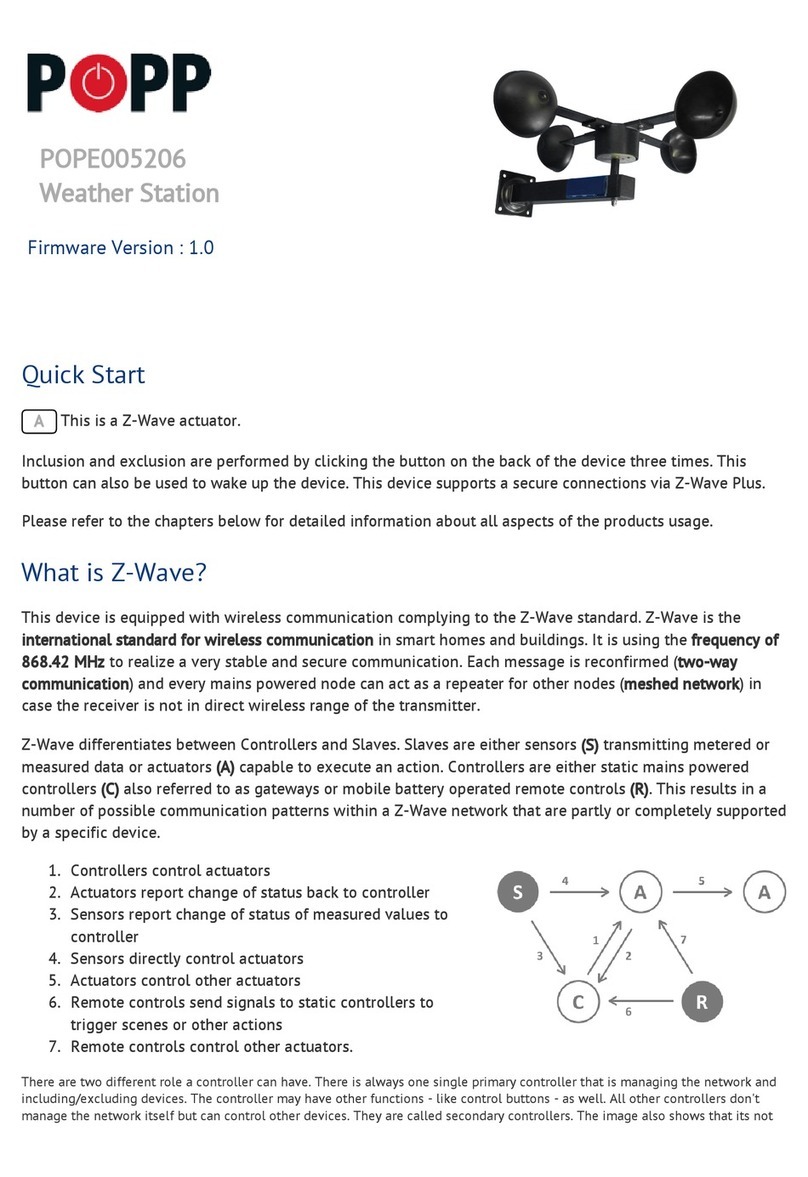Hold the button longer than 1.5 seconds and then release. The LED blinks longer than when pressing the button once.
Installation
Before you can configure and use Z-Weather, the unit needs to be fully charged. In order to charge Z-Weather place it in a location with direct sunlight exposure for 4-6
hours. Without Z-Weather: Operating elements Function Button and Status LED Solar Cell 3 direct sun light the charging may take up to 12 hours. To check if Z-
Weather has been charged sufficiently, press the button located under the cup anemometer. If the LED blinks after pressing the button, Z-Weather is charged and
operational.
Most of Z-Weather!s sensors are placed inside the top of the ball-bearing cup anemometer and they are measuring the environmental parameters inside the black
round housing. If the sun is shining and Z-Weather is placed in direct sunlight, the housing will warm up and the temperature is higher than the temperature outside the
housing. Thus a place in the shadow is the best choice for placing Z-Weather. Even though Z-Weather is powered by a solar cell, it is not required to place Z-Weather
exposed to direct sun light and there is no need to face it south. The solar cell will produce sufficient energy to power Z-Weather, even if the solar cell is facing north
and the device is in the shadow all day.
Inclusion/Exclusion
On factory default the device does not belong to any Z-Wave network. The device needs to be added to an existing wireless network to communicate with the
devices of this network. This process is called Inclusion.
Devices can also be removed from a network. This process is called Exclusion. Both processes are initiated by the primary controller of the Z-Wave network. This
controller is turned into exclusion respective inclusion mode. Inclusion and Exclusion is then performed doing a special manual action right on the device.
Inclusion
1. Charge the device by solar radiation for approx. 24h.
2. Press the button on the bottom of the device three times in succession.
Exclusion
1. Charge the device by solar radiation for approx. 24h.
2. Press the button on the bottom of the device three times in succession.
Product Usage
Z-Weather is maintenance free and works environmentally friendly using solar power, it does not contain any batteries. The solar cell charges an internal capacitor,
which buffers all harvested energy and powers the electronic components during the night. When first operating Z-Weather after installation, it is required to fully
charge the device by placing it in direct sunlight for 4-6 hours. Even though the capacitor is pre-charged at the factory, the capacitor has most likely lost most of its
energy and does not provide sufficient power for operating Z-Weather immediately after unpacking. If the capacitor is completely empty it must be charged from 0% to
100% which takes longer than in subsequent charging cycles.
Once Z-Weather is installed and operating, it is charged on a day by day base and the capacitor will never be discharged completely. If the capacitor is completely
discharged, which only can happen at time of delivery if Z-Weather was stored at a dark place for weeks, charging may need up to 6 hours in direct sunlight during
summer and up to 2 days during winter solstice and grey sky. In order to check the functionality of Z-Weather and test whether the device has sufficient energy to
operate, press the button located under the anemometer. If the LED blinks, Z-Weather has enough energy to operate. 5 It is good practice to perform the initial setup of
Z-Weather at noon. After the first charging cycle is completed, the device will have stored enough energy for setup and adding the device to the Z-Wave network.
However if you want to experiment with settings, or use the power consuming POWERLEVEL command class, Z-Weather may quickly use up all its energy reserve
and may need to be charged again. If you configure Z-Weather at noon, the device had the entire morning for a full charge, has strong sun light when it uses the most
energy (during configuration) and has the complete afternoon for recharging. As a rule of thumb: After pressing the button eight times, Z-Weather will have used up the
energy stored. When the energy has been used up, the LED does not blink and Z-Weather needs to be charged for approximately 1-2 hours.
Node Information Frame
The Node Information Frame (NIF) is the business card of a Z-Wave device. It contains information about the device type and the technical capabilities. The inclusion
and exclusion of the device is confirmed by sending out a Node Information Frame. Beside this it may be needed for certain network operations to send out a Node
Information Frame. To issue a NIF execute the following action: Push the button 3 times within 1.5 seconds.
Communication to a Sleeping device (Wakeup)
This device is battery operated and turned into deep sleep state most of the time to save battery life time. Communication with the device is limited. In order to
communicate with the device, a static controller Cis needed in the network. This controller will maintain a mailbox for the battery operated devices and store
commands that can not be received during deep sleep state. Without such a controller, communication may become impossible and/or the battery life time is























